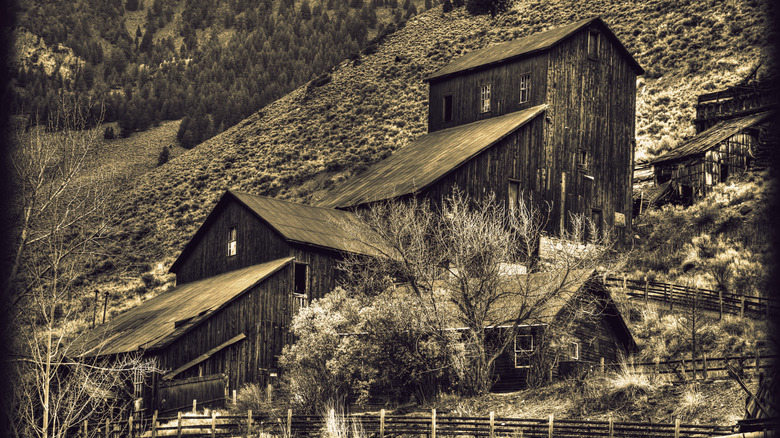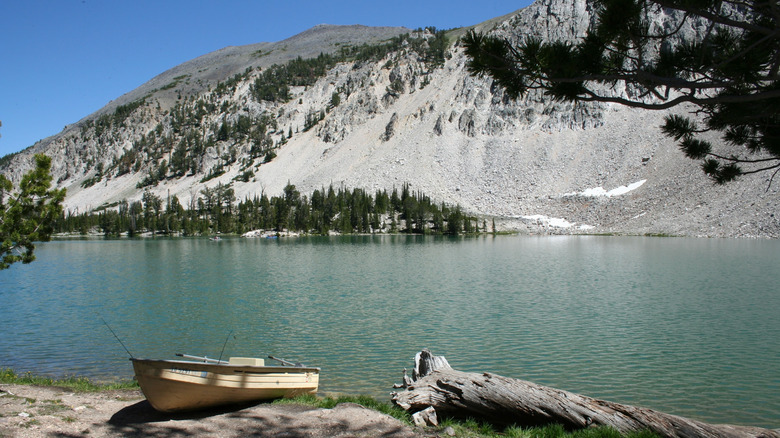The Eerie But Hauntingly Beautiful Idaho Ghost Town That May Be Dangerous To Explore
When we think of the American West, images of sagebrush, rugged mountains, pine forests, and tumbleweeds spring to mind. This vast area offers some of the country's most arresting and iconic outdoor attractions — many of which are perfectly experienced via a scenic road trip — and also looms large in the collective imagination. Much of this is due to the region's history, which is a story of proud natives, determined settlers, cowboys, conflict, resilience, and the boom-and-bust communities that came to define it. The remnants of some of these settlements still stand today in the form of ghost towns. These abandoned collections of clapboard buildings dot the West and have become magnets for enthusiasts eager to take in a bit of history, along with the forlorn, otherworldly atmosphere that usually surrounds them.
One such place is the tiny community of Gilmore, Idaho. Situated 65 miles south of the town of Salmon just off lonely Highway 28, this once-thriving mining settlement was abandoned long ago. The collection of around 20 dilapidated buildings now attracts visitors keen to understand a bit of the past while also soaking up the gorgeous natural surroundings. That said, Gilmore also possesses a perilous legacy in the form of the heavy metals found in the soil throughout the site, which may make you think twice about heading there.
Feel the mountain breeze blow through the skeletons of buildings
Gilmore was founded in the early 1900s as a center for lead and silver mining and quickly ballooned to a boom town with over 600 residents. It was, in fact, a terminus of the Gilmore and Pittsburgh Railroad, which was opened in 1910 to transport ore up and over the Continental Divide to Montana. In 1927, the power plant that powered the mine was destroyed in an explosion, which caused most residents to move away. By the end of the 1930s the town was almost entirely abandoned, and the railroad ceased operations by 1940.
Today, Gilmore is a collection of rundown buildings, many of which are on private property. The original town sits high on the hillside and is available for exploration, where you can take in the four structures that remain untouched, which are accompanied by interpretive signage, as well as marvel at the sweeping views of the wide valley and surrounding mountains.
Gilmore is located at the base of the Lemhi Range, which is home to 10 peaks in excess of 11,000 feet in elevation. This is a very scenic area of east-central Idaho, which makes it a worthy destination just for its natural splendor alone. Also, just 5 miles up the gravel road from Gilmore is Meadow Lake Campground, a Salmon-Challis National Forest site situated on the shores of a crystalline, alpine lake, making the ghost town a perfect pit stop while heading into the hills to enjoy more natural pursuits.
Proceed with caution when visiting Gilmore, Idaho
Despite Gilmore's mysterious allure, the ghost town and the surrounding area was home to around 60 mines in its heyday, resulting in an unsavory legacy. All of this activity left behind potentially toxic waste material in the form of rocks, tailings, and ore that, over the decades, became distributed throughout the area by water and wind. This has resulted in soil contamination. According to a study done by the Idaho Department of Environmental Quality, the soil and dust at the Gilmore site contains levels of lead at 50+ times higher than considered safe near a residence, as well as traces of arsenic.
These substances can enter the body through inhalation or ingestion, so any visit to Gilmore should be kept short, as it's nearly impossible to completely avoid exposure. Kids and pregnant women are especially at risk, so it's best to be avoided. But if you are committed to visiting, perhaps the best way to take in the ghost town is by stopping off briefly while wearing face masks, or even from the relative safety of your vehicle.
While the United States Environmental Protection Agency had considered making Gilmore a Superfund cleanup site, vigorous opposition by local landowners caused them to scrap the plan. This means that — at least for the time being — nothing will be done to reduce the risk of exposure to lead, arsenic, and other heavy metals in the area, so visit at your own risk. If you want to visit a similar place that's less dangerous, check out one of the best-preserved ghost towns in Montana's scenic glacier country.


